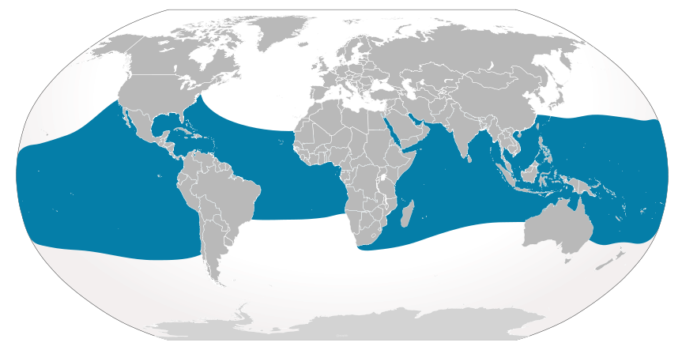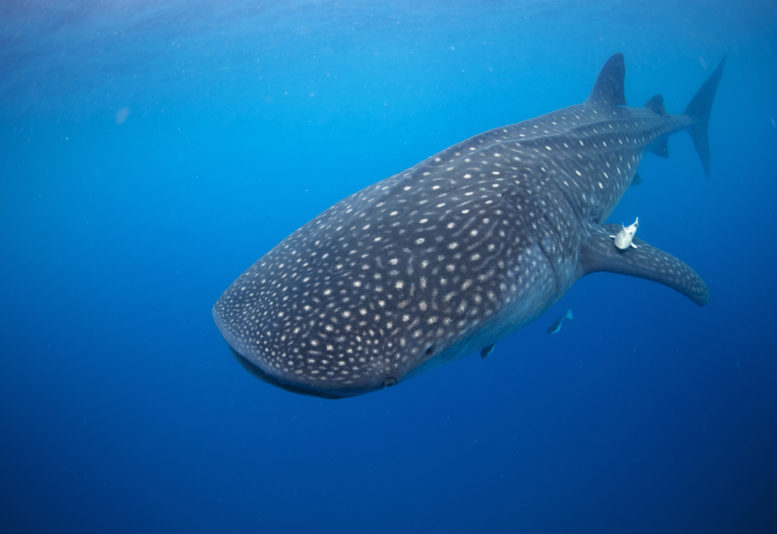Description. The Whale Shark (Rhincodon typus) is a filter-feeding shark, very slow moving, and the largest known fish species in existence. The largest confirmed Whale Shark had a length of 41.5 ft and a weight of 47,000 lbs according to Gerald L. Wood (1976) in The Guinness Book of Animal Facts and Feats. There are undocumented or unconfirmed claims of considerably larger individuals, over 46 ft long and weighing at least 66,000 lbs.
The Whale Shark is most notably by far the largest living non-mammalian vertebrate. It is the sole member of the genus Rhincodon and the only extant member of the family, Rhincodontidae. The species originated about 60 million years ago.
A whale is larger in size than a Whale Shark. But a whale is not a fish; it is a mammal because it breathes air and does not have gills. The Whale Shark is not a mammal; it is a fish. Thus, the Whale Shark is the largest fish in the world, while the Blue Whale is the largest mammal in the world.
The “whale” in its name directly refers to this shark’s size for being as large as some species of whales, and having a filter feeder like Baleen Whales.
The Whale Shark has a feeding modality used by only two other sharks, the Megamouth Shark and the Basking Shark. It feeds largely on algae called plankton, and completely harmless to humans.
The 1984 Food and Agriculture Organization (FAO) Species Catalogue Volume 4 – Sharks of the World by LJV Compagno states that although the Whale Shark’s large mouth can be over 5 ft in width, it is armed with only the tiniest of teeth, arranged in about 300 rows, and 10 filter pads that are used to filter feed. It has 5 large pairs of gills in order to breathe while feeding. Their head is wide and flat with two small eyes at the front. Whale Sharks are grey with a white belly. Its skin can be up to 4 inches thick. Their skin is marked with a checkerboard pattern of pale yellow spots and vertical stripes that are unique to each individual, and can also serve as camouflage. The Whale Shark has three prominent ridges along its sides. The Whale Shark has a pair of dorsal fins and pectoral fins. The juvenile Whale Shark tails have a larger upper fin than lower fin, while the adult tail becomes semilunate, or crescent-shape. The Whale Shark’s spiracles are just behind its eyes. They function like gills when it dives into the deep ocean bottom to rest, or when they bury under the sand.
Slow swimmers. The Whale Shark is not an efficient swimmer. Its entire body is in motion, swaying left to right, while it swims. The result of this motion is one that is very unusual for sharks — an average speed of around 5 km/hr. When most sharks are said to be harmless to humans, the Whale Shark species is used as the leading example. Divers and snorkelers can swim around the gentle giant shark without any problems.
Feeding. The Whale Shark feeds on plankton including cope pods, krill, fish eggs, red crab larvae, and small nektonic life such as small squid or fish. It also feeds on clouds of eggs during mass spawning of fish and corals, but does not use its 3,000 teeth. It is a suction filter feeder and sieves its food through its large gills as it swims with its mouth open. When feeding, it swallows large amounts of prey, and expels the excess water through its gill slits.
The 1984 FAO Species Catalogue Volume 4 – Sharks of the World finds the Whale Sharks to be highly migratory, with their movements probably timed with blooms of planktonic organisms and changes in temperatures of water masses. They are also often associated with the presence of schools of pelagic fish called scombrids. Whale Sharks migrate to feed and possibly to breed.
Distribution and habitat. The Whale Shark can be found in open waters of the tropical oceans, and is rarely in waters with temperatures below 22 °C or 72 °F. The Whale Shark inhabits all tropical and warm-temperate seas. According to Brian C. Howard (2016) in his article in the National Geographic Society, the Whale Shark is primarily pelagic, meaning, it lives in the open sea but not in the greater depths of the ocean, yet it is known to occasionally dive to depths of as much as 5,900 ft.

Tropical Band range for the Rhinocodon typus. Photo Credit: The Emirr
Although typically seen far offshore, Whale Sharks have been found closer to land, entering inshore lagoons or coral atolls, and near the mouths of estuaries and rivers. The Whale Shark, however, is solitary and rarely seen in groups unless feeding at locations with an abundance of food.
In Asia, Whale Sharks have been spotted near the coast of Pakistan; Philippines; Thailand; Malaysia; Indonesia, Sri Lanka, China, Japan, Papua New Guinea, Vietnam, and Taiwan.
In the Philippines, seasonal feeding aggregations and Whale Shark spottings occur between December and May at several coastal sites, the most popular of which would be Donsol, Sorsogon; Oslob and Moalboal, Cebu; Panglao, Bohol; Sogod Bay and Limasawa Island, Southern Leyte; Mercedes, Camarines Norte; Pasacao, Camarines Sur; Sablayan, Occidental Mindoro; Coron, El Nido, Puerto Princesa, Palawan; and Batangas.
The Whale Shark is fondly called Butanding in the Philippines; Ca Ong or “Lord Fish” in Vietnam. Marokinata or “Many Stars” in Madagascar; and Geger Lingtan or “Stars in the Back” in Indonesia.
Reproduction. The reproductive process of most sharks is uncertain. They could be oviparous or ovoviviparous. The 1984 FAO Species Catalogue Volume 4 – Sharks of the World by LJV Compagno stated that based on studies on a large single egg (18 x 6 x 4 inches) containing a nearly full-term 14 inch Whale Shark embryo recovered off the Gulf of Mexico in 1953, the specie was believed to be oviparous (egg-laying). However, an alternative explanation (Wolfson, 1983) was that the egg was aborted before term, and thus the Whale Shark is ovoviviparous instead.
Later, the capture of a pregnant female in July 1996 containing 300 young pups indicated that Whale Sharks are oviparous with ovoviviparous development. The eggs remain in the body of the female White Shark, and the females give birth to live pups of 16-24 inches long. Evidence from research (Jennifer Schmidt, et. al. 2010, “Paternity Analysis in a Litter of Whale Shark Embryos,” for the Endangered Species Research) indicates the pups are not all born at once. Rather, the female retains sperm from one mating, and produces a steady stream of pups over a prolonged period. It is believed that they reach sexual maturity at around 30 years, and their life span has been estimated to be in the range of 60-150 years, averaging 70 years.
Conservation. The IUCN Red List of Threatened Species 2016 has classified the Whale Shark as Endangered due to the impacts of fisheries, bycatch losses, and vessel strikes, combined with its long life span and late maturation.
The Whale Shark is also included in a number of international conventions and agreements such as the Convention on International Trade in Endangered Species of Wild Fauna and Flora (CITES), the Convention on Migratory Species (CMS), and the United Nations Convention on the Law of the Sea (UNCLOS).
Australia’s Department of Environment and Energy reported that Asian countries such as the Maldives banned all fishing, selling, importing, and exporting of whale sharks for commercial purposes in June 1995; the Philippines in March 1998; followed by Thailand in March 2000; India in May 2001, and Taiwan in May 2007. However, illegal fishing and related activities still occur despite the laws in place. Western Australia and the USA, in contrast, fully protect the Whale Sharks.
By law, divers and snorkelers must maintain a distance of at least 4 feet from the Whale Sharks, and there is a fine and possible jail time for anyone who touches these gentle giants.
